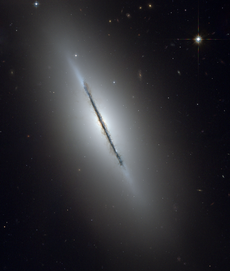The Galaxy
There are various kinds of
galaxies in our universe which are formed by millions of stars, dusts and gases
in the outer space. Our solar system is located in the milky way of the galaxy
in a spiral shape. Ther ara millions of galaxies in the shape of spiral,
ellipse and non-uniform or irregulars in the universe. These galaxies are located far away
from one another in the outer space
Example of elliptical galaxies:
Galaxies come in three
main types: ellipticals, spirals, and irregulars. A slightly more extensive
description of galaxy types based on their appearance is given by the Hubble
sequence. Since the Hubble
sequence is entirely based upon visual morphological type, it may miss certain
important characteristics of galaxies such as star formation rate (in starburst galaxies) and activity
in the core (in active galaxies).[7]
Types Of Galaxies
Types of galaxies according to the Hubble classification scheme. An Eindicates a type of elliptical galaxy; an S is a spiral; and SB is a barred-spiral galaxy.
The elliptical galaxies
The most massive
galaxies in the sky are giant elliptical galaxies. Their stars are on orbits that are randomly
oriented within the galaxy (i.e. they are not rotating like disk galaxies).
They are composed of old stars and have little to no dust. All elliptical
galaxies probed so far have supermassive
black holes in
their center, and the mass of these black holes is correlated with the mass of
the elliptical galaxy. They are also correlated to a property called sigma which is the speed of the stars at the far
edge of the elliptical galaxies. Elliptical galaxies do not have disks around
them, although somebulges of disk galaxies look similar to
elliptical galaxies. One is more likely to find elliptical galaxies in more
crowded regions of the universe.
Example of elliptical galaxies:
 |
| ESO 325-G004, a typical elliptical galaxy |
The spiral galaxies
The key properties of disk galaxies, which are also commonly called spiral galaxies, is that they are very thin, rotate rapidly, and
often show spiral structure. One of the main challenges to galaxy formation is
the great number of thin disk galaxies in the local universe. The problem is
that disks are very fragile, and mergers with other galaxies can quickly
destroy thin disks.
Examples of spiral galaxies:
 |
| NGC-4414, A typical spiral galaxy |
 |
| Messier 101, A prototypical spiral galaxy |
 |
| Milky Way (our galaxy)-a spiral galaxy |







5 comments:
The pictures are nice and the information are clear . I like it a lot.
Thank You, Sharon.
Thank You, Sharon.
The galaxy is great.Thank you teacher.
I learn a lot.
Great that you learn something from my blog, Ivan.
Post a Comment